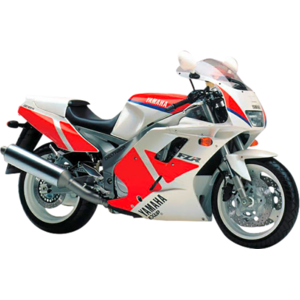Yamaha FZR 1000 EXUP (1989-1990): The Genesis of Modern Superbikes
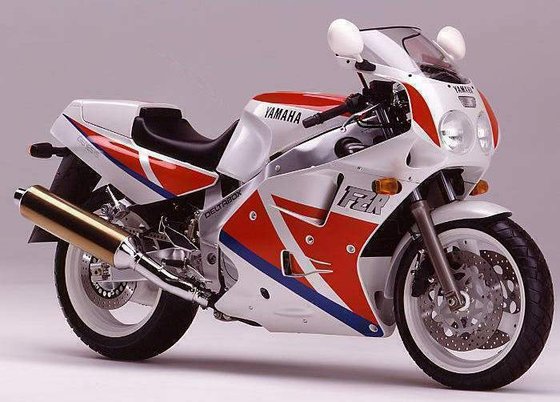
Overview
When Yamaha unleashed the FZR 1000 EXUP in 1989, it didn’t just release a motorcycle – it dropped a manifesto. This was the machine that redefined what a liter-class sportbike could be, blending racetrack DNA with real-world usability in a way that still feels revolutionary today. For riders in the late '80s and early '90s, the EXUP wasn’t just another superbike; it was the benchmark.
Swinging a leg over the FZR today, what strikes you first isn’t the period-correct angular styling (though those twin headlights remain iconic), but how modern it feels. The riding position is committed but not punishing, the controls fall naturally to hand, and there’s an immediate sense of mechanical integrity. This isn’t some temperamental garage queen – it’s a machine begging to be ridden hard.
Engine Performance: Where Physics Meet Sorcery
At the heart of the EXUP experience lies its 1002cc inline-four – an engineering masterpiece that still makes modern riders’ jaws drop. Let’s break down why:
The EXUP Revolution
Yamaha’s Exhaust Ultimate Power valve wasn’t just marketing fluff. This servo-controlled butterfly valve in the exhaust header transformed the engine’s personality: - Below 7,000 RPM: Restricts exhaust flow, boosting low-end torque - Above 8,500 RPM: Flips wide open, unleashing top-end fury
The result? A powerband that feels supernatural. Crack the throttle at 3,000 RPM in sixth gear, and the FZR pulls with V8-like authority. Keep it pinned, and the tachometer sweeps toward the 10,500 RPM redline with turbine-like smoothness. Yamaha claimed 145 HP at the crank – and you believe every pony’s accounted for when the horizon starts rushing at you like a rewound VHS tape.
Technical Ballet
- 20-Valve Head: Three intake/two exhaust valves per cylinder
- Forward-Inclined Cylinders: 35° tilt for mass centralization
- Mikuni BDST38 Carburetors: Crisp throttle response (when properly synced)
The numbers still impress:
- 0-100 km/h (0-62 mph): 2.9 seconds
- Standing ¼ Mile: 10.1 seconds @ 217 km/h (135 mph)
- Top Speed: 273 km/h (170 mph)
But numbers don’t capture the FZR’s party trick – making apocalyptic speed accessible. The power delivery is so linear, so damn polite, that triple-digit speeds arrive with less drama than brewing coffee.
Chassis & Handling: Aluminum Alchemy
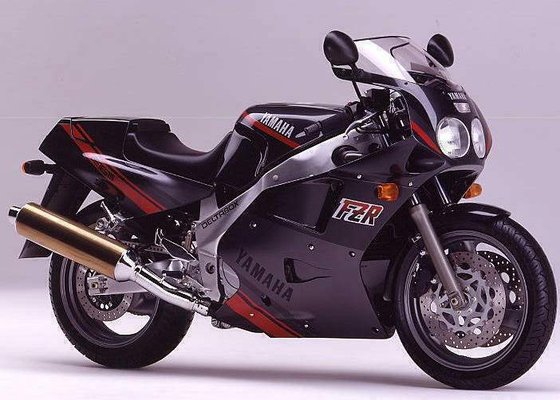
The Deltabox frame wasn’t just revolutionary – it became the blueprint for modern sportbike design. Yamaha’s aluminum twin-spar creation did three groundbreaking things:
- Stressed-Member Engineering: The engine bolts directly to the frame’s beefy cast sections
- Torsional Rigidity: 41% stiffer than previous steel frames
- Weight Distribution: 52% front/48% rear at rest
On the road, this translates to telepathic handling. The FZR flicks into corners with the urgency of a 600cc supersport, yet remains unshakably stable at speeds that would make most '90s bikes weave like drunken sailors. Credit the fully adjustable suspension: - Front: 43mm conventional forks (10W oil) - Rear: Monoshock with rising-rate linkage
Ground clearance is generous (135mm/5.3"), letting you scrape pegs without drama. The Bridgestone Battlax tires (130/60-17 front, 170/60-17 rear) feel dated by modern standards but work surprisingly well with the chassis’ feedback-rich nature.
Braking: Stopping the Space Shuttle
Stopping 236 kg (520 lbs) of missile requires serious hardware: - Front: Dual 320mm discs with four-piston calipers - Rear: 267mm disc with single-piston caliper
Initial bite lacks the razor-sharp feel of radial masters, but there’s immense power waiting mid-stroke. Under heavy use, the brakes fade less than period rivals – a testament to Yamaha’s floating disc design. For canyon carving, they’re more than adequate; for track days, consider upgrading to sintered pads (available at MOTOPARTS.store).
Ergonomics: The Gentleman’s Sportbike
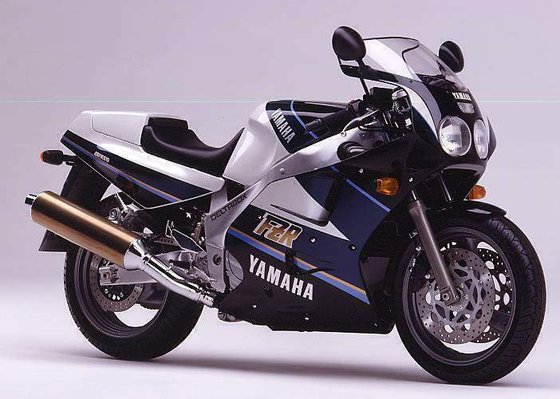
Where modern liter bikes punish your wrists and kidneys, the FZR remains shockingly livable: - Seat Height: 765mm (30.1") – accessible for most riders - Footpegs: Set relatively low for a sportbike - Bars: Clip-ons with a 15° rise
You’ll feel some weight on your palms during all-day rides, but the seat’s generous padding (by sportbike standards) helps. Wind protection from the bikini fairing is better than expected – stable up to 200 km/h (124 mph) before buffeting becomes intrusive.
Competition: Kings of the '90s Jungle
The EXUP didn’t exist in a vacuum. Here’s how it stacked up against contemporaries:
1. Honda CBR900RR Fireblade (1992)
Lighter (208kg/459lbs) but less powerful (124HP)
FZR Advantage: Superior top-end power, better high-speed stability
Upgrade Tip: Match the Fireblade’s agility with a 520 chain conversion kit
2. Kawasaki ZX-10 (1990)
Brutal 997cc engine (137HP) but portly (245kg/540lbs)
FZR Advantage: More refined power delivery, better fuel range (19L vs 16L)
Upgrade Tip: Out-brake the Kawasaki with stainless brake lines
3. Suzuki GSX-R1100 (1990)
Raw power (147HP) with primitive chassis
FZR Advantage: Modern suspension, predictable handling
Upgrade Tip: Close the power gap with a free-flow air filter
Maintenance: Keeping the Legend Alive
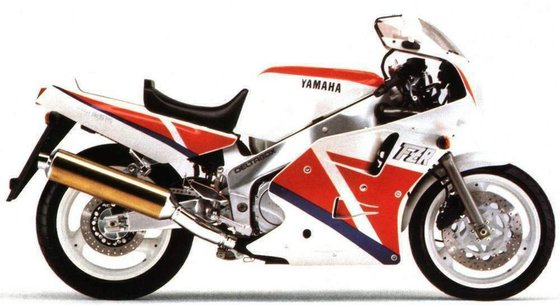
The FZR’s mechanical simplicity makes it a DIY dream. Key considerations:
1. Valve Adjustments
- Intake: 0.11-0.20mm (0.0043-0.0079")
- Exhaust: 0.21-0.30mm (0.0083-0.0118")
Pro Tip: Use MOTOPARTS.store’s NGK DR8EIX iridium plugs (gap 0.7mm) for smoother running
2. Carb Tuning
- Pilot Screws: 2.5 turns out (baseline)
- Sync Tool: Essential for smoothing idle
Pro Tip: Replace intake manifold O-rings every 15,000 km (9,300 miles)
3. Suspension Refresh
- Fork Oil: 10W (stock) or 15W for heavier riders
- Rear Shock: Check nitrogen pressure (1,300kPa/189psi)
Pro Tip: Upgrade steering head bearings to tapered rollers
4. Brake Service
- Fluid: DOT 4 (replace biannually)
- Pads: MOTOPARTS.store’s sintered HH compound for better bite
5. Chain & Sprockets
- Stock Gearing: 17T front/47T rear
- Chain: DID 530VX3 (110 links)
Pro Tip: Fit a Scottoiler for longer chain life
The MOTOPARTS.store Advantage
While the FZR was built to last, three decades take their toll. Keep your EXUP prime with: - OEM-Spec Filters: Exact-fit oil & air filters - Carb Rebuild Kits: Complete with jet needles - EXUP Cable Kits: Prevent valve sticking - Frame Sliders: Protect that iconic Deltabox
Conclusion: Timeless Thrills
Riding the FZR1000 EXUP today isn’t nostalgia – it’s revelation. This is the bike that proved you could have racetrack performance without sacrificing road manners, that engineering could enhance rather than complicate the riding experience.
Does it feel its age? In details like the cable-operated clutch and analog gauges, sure. But in the way it melds power, poise, and personality? The EXUP could roll off showroom floors tomorrow and still shame modern pretenders. For riders who want to experience motorcycling history without museum-piece fragility, the FZR remains peerless – a mechanical sonnet written in aluminum and adrenaline.
Specifications sheet
| Engine | |
|---|---|
| Stroke: | Four-stroke |
| Ignition: | TCI digital ignition |
| Max power: | 105.7 kW | 142.0 hp |
| Max torque: | 107 Nm |
| Fuel system: | 4x 38mm Mikuni BDST carburetors |
| Lubrication: | Wet sump |
| Max power @: | 10000 rpm |
| Displacement: | 1002 ccm |
| Max torque @: | 8500 rpm |
| Configuration: | Inline |
| Cooling system: | Liquid |
| Compression ratio: | 12.0:1 |
| Number of cylinders: | 4 |
| Valves per cylinder: | 5 |
| Dimensions | |
|---|---|
| Wheelbase: | 1460 mm (57.5 in) |
| Dry weight: | 209 |
| Wet weight: | 236 |
| Seat height: | 765 mm (30.1 in) |
| Overall width: | 730 mm (28.7 in) |
| Overall height: | 1160 mm (45.7 in) |
| Overall length: | 2200 mm (86.8 in) |
| Ground clearance: | 135 mm (5.3 in) |
| Fuel tank capacity: | 19 L (5.02 US gal) |
| Drivetrain | |
|---|---|
| Clutch: | Wet, multi-disc |
| Final drive: | chain |
| Chain length: | 110 |
| Transmission: | 5-speed |
| Rear sprocket: | 47 |
| Front sprocket: | 17 |
| Secondary reduction ratio: | 68/41 (1.659) |
| Maintainance | |
|---|---|
| Rear tire: | 170/60-17 |
| Engine oil: | 20W40 |
| Front tire: | 130/60-17 |
| Brake fluid: | DOT 4 |
| Spark plugs: | NGK DR8ES-L or NGK DR8EIX |
| Spark plug gap: | 0.7 |
| Coolant capacity: | 2.8 |
| Engine oil capacity: | 3.0 |
| Valve clearance (intake, cold): | 0.11–0.20 mm |
| Valve clearance (exhaust, cold): | 0.21–0.30 mm |
| Recommended tire pressure (rear): | 2.6 bar (38 psi) solo, 2.9 bar (42 psi) with passenger |
| Recommended tire pressure (front): | 2.4 bar (35 psi) / 2.5 bar (36 psi) |
| Chassis and Suspension | |
|---|---|
| Rake: | 26.7° |
| Frame: | Aluminum Deltabox |
| Trail: | 110 mm (4.33 in) |
| Rear tire: | 170/60 v-17 |
| Front tire: | 130/60 v-17 |
| Rear brakes: | Single 267 mm disc, 1-piston caliper |
| Front brakes: | 2 x 320 mm discs, 4-piston calipers |
| Rear suspension: | Monoshock, adjustable preload and damping |
| Front suspension: | 43mm telescopic fork, adjustable preload |
| Rear wheel travel: | 130 mm (5.1 in) |
| Front wheel travel: | 120 mm (4.7 in) |



